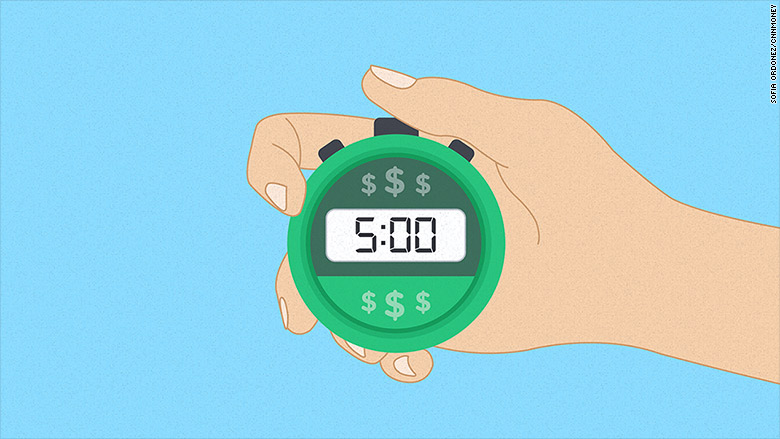
So you've signed up for your company's 401(k) plan. Good job! Now what?
A 401(k) is a great place to start saving for retirement because pre-tax dollars are taken straight from your paycheck. Plus, a lot of employers will match what you contribute.
Sounds easy enough. But when it comes to investing those funds, you do have some options and the choices can be confusing.
Here's a quick and easy way to invest in 4 steps.
1. Save 10% of your income
First, set how much of your paycheck will be automatically transferred into your 401(k) each pay period. This can be done online with the click of a few buttons -- and without having to talk to anybody.
How much should you contribute?
While 10% of your gross annual income is a general rule of thumb, many financial planners suggest trying to save at least 15% and as much as 20% -- especially if you're getting a late start on retirement saving.
Making big bucks? Because of a government cap, you might not be able to stash the entire 10% of your income in your 401(k). You're currently limited to $18,000 a year if you're under 50, or $24,000 if you're older. Think about opening a traditional or Roth IRA if you want to save more, but those accounts have even lower caps.
Of course, not everyone can afford to save 10% of their income.
"The number one rule is to start saving whatever you can," said Drew Weckbach, a CFP and founder of the firm Scaling Independence.
In that case, contribute at least enough to take full advantage of your employer's match. If your company matches up to 3% of your income, then shoot for 3% to avoid leaving money on the table.
Related: How much you should have saved for retirement now
2. Set your mix of stocks and bonds
Every company's plan offers a different menu of funds. The choices can sometimes be overwhelming. Other companies don't offer many choices at all.
But the basics of investing for retirement are fairly simple: The younger you are, the more risk you should take on. It's a personal decision, but some experts suggest having about 90% of your savings in stocks if you're more than 30 years away from retirement. Someone 10 years away should have about 70% in stocks. The rest should be in less-risky bonds, money market funds or cash.
3. Choose your investments...
Ideally you want some exposure to a variety of different stocks -- companies of different sizes and from various parts of the world. But if you don't know what you're doing this can feel like picking out of a hat.
There's no one portfolio that's right for everyone. But here's a sample that Weckbach suggests for someone who's shooting for a mix of 80% in stocks and 20% in bonds.
Start by allocating about 30% of your contributions to a large-cap index fund. This puts your money in stocks of some of the largest companies listed on a major index like the S&P 500. Think Apple (AAPL), Coca-Cola (CCE), and GE (GE).
He then suggests putting about 15% in a mid-cap fund and another 15% in a small-cap fund. These will give you exposure to different sized companies with a market cap below about $10 billion.
Then look for an international fund so that about 20% is invested in stocks of foreign companies.
The remaining 20% can go into a bond fund.
If you work for a small business, your plan might not offer a lot of these funds. If that's the case, stick to a large-cap index fund and a bond fund.
...Or just make it automatic
Your company might make the decision even easier by offering funds that do the work for you. A professionally managed fund that picks investments might be the only one you need, according to Conor Weir, a CFP and managing director at Retirement Benefits Group.
For example, maybe you have a choice of 3 diversified, managed funds: a conservative, moderate, or aggressive fund. Each one is more heavily weighted in stocks than the last. Just choose the one that corresponds to your age and level of risk. A young investor, for example, should go with the aggressive option. As you get older, you may want to shift into a different fund.
A target date fund might be an even simpler option. Most will have a year in the fund's name, like the "Vanguard Target Retirement 2020 (VTWNX)," for example. Choose one with the year that's closest to when you plan to retire. It not only sets your investments but also automatically transitions them to more conservative assets as you get closer to retirement.
3. Don't meddle with your choices
While all your future contributions will always be invested in the manner you chose, any existing investments that you've accumulated could be thrown off balance by market fluctuations. For example, you could end up with more international holdings than you intended, or a little too heavy on small-cap stocks. That's why you need to check in about once or twice a year.
But other than a quick rebalance to make sure your investments are still allocated the way you wanted, there's no reason to change anything in your 401(k) if the market takes a dive. Retirement is a long-term investment so you should be able to ride out the ups and downs.
"If you set a good allocation in the beginning, you only need to rebalance it every six months or annually," said Weir.
